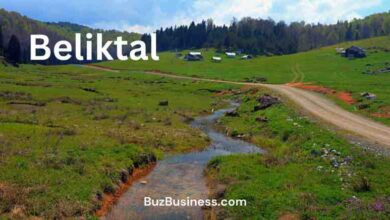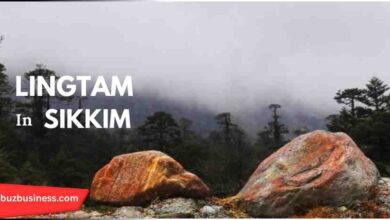Most Beautiful Waterfalls to Visit in India
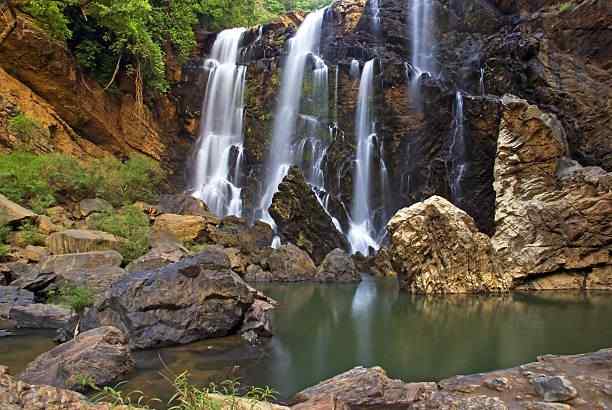
India is a country that’s made a name for itself in the world with its rich culture and heritage. With a booming film industry, art, and delicious cuisine that’s spread to different parts of the world, it comes as no surprise that it’s considered one of the places one should tick off their travel list.
For many locals, they take pride in their land and history, that’s led to a diverse range of languages. Without a doubt, India provides a range of activities for you to not only do but also places to be. It’s a place that offers a space for those who enjoy nature, with beautiful waterfalls that each have their unique feature.
So if you love nature that comes with interesting myths, then you might need to consider visiting the following landmarks if you ever get the chance.
Top 10 Waterfalls in India
Jog Falls (Karnataka)
Located along the Sharavathi River. Not only is it the second-highest plunge, standing at a height of 253 m, but it splits into four streams. Locals suggest the Jog Falls were once cursed by a sage, and when the waterfall splits into the four streams, each of them represents a different emotion: anger (Roarer), calmness (Rani), pride (Raja), and speed (Rocket). The best time to visit would be during the Monsoon when all four of these cascades are in full force.
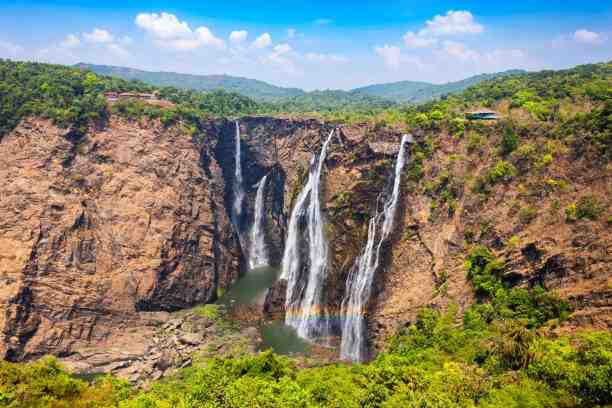
There are nearby attractions for you to visit, including the Linganamakki Dam, which is a key player in the generation of hydroelectric power. Honnemaradu is another place many visit. It’s a village that got its name from the Honne tree. Whenever the sun hits the backwaters, making it look like gold, it’s easy to understand why the meaning of Honnemaradu is “golden lake”. It’s also the perfect place for those who enjoy birdwatching to visit and observe the variety of birds.
Another attraction is the Dabbe Falls, a beautiful waterfall where the water looks like it’s cascading down steps and drops about 110 m. The name “dabble” in Kannada means steps and has crystal clear pools for anyone to enjoy a swim and a serene view that needs to be captured in a photo.
Dudhsagar Falls (Goa/Karnataka border)
This particular waterfall has a milky white appearance that’s led to it being known as the “Sea of Milk”. Towering at an impressive height of 310 m, it’s one of the tallest falls in India and flows from the Mandovi River. The river itself provides sustainable drinking water to nearly half of Goa. The falls also have a range of attractions, such as the Bhagwan Mahavir Wildlife Sanctuary for animal enthusiasts and Devil’s Canyon for those who love nature walks and taking in the vibrant greenery.
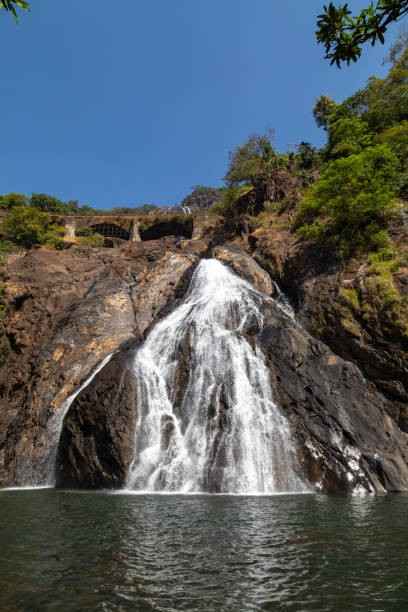
But other than the scenic views, some believe it got its name from a princess who once bathed in a lake near the falls whilst drinking milk from a golden jug. When a prince approached, to maintain some form of modesty, she poured the milk into the falls to create a curtain. The best time to visit and see this “Sea of Milk” is between October and February to avoid the peak monsoon, when it will be more accessible.
Athirappilly Falls (Kerala)
Believed by locals to be an area protected or haunted by forest spirits, this waterfall stands at a height of 24 m. It’s the widest waterfall in Kerala and is often referred to as the “Niagara of India”. It’s situated on the Chalakudy River, where sightings of elephants are considered sacred, with these sightings more common during dusk, adding an air of mysticism and intrigue to the area.

The best times to visit are from June to September during the monsoon season, when the Indravati River flows will be in full force, offering an intense experience for anyone who visits the falls during this period. But for those who prefer a calmer environment, the post-monsoon period from November to February is the best time to go.
The area is also near the Vazhachal Falls. Not only does it provide gorgeous views, but it’s known for being the only place in the Western Ghats where four of the endangered hornbill species are found. The area is filled with wildlife, from not only elephants but even small creatures such as butterflies that can be found in the Thumboormuzhi Gardens. With a variety of butterfly species and a scenic hanging bridge that provides amazing views, it’s easy to see why it’s a favorite among tourists.
Nohkalikai Falls (Meghalaya)
With a height of 340 m, it’s the tallest plunge waterfall in the country. It’s said to have gotten its name after a woman named Ka Likai was driven by grief into madness after unknowingly eating her murdered daughter’s flesh cooked by her jealous second husband. Her grief drove her to jump off the cliff, and many believe to this day that her soul still lingers and wanders around the misty cliffs.

Not too far from these falls is the Mawsmai Cave, a natural limestone cave. With impressive rock formations, due to how easily accessible it is, it’s a suitable place for explorers. Due to having formations that include stalagmites and stalactites, it’s a place where fossils can be found, making it a must-see attraction when anyone visits the falls.
Another attraction is the Living Root Bridges, which are structures crafted by the Khasi and Jaintia people. They guided and wove the aerial roots of an Indian rubber tree over streams and rivers.
These structures are a true testament to the local communities’ deep relationship and understanding of nature. The best time to consider coming to the falls would be during the post-monsoon season, which is between September and November.
Bhagsu Waterfall (Himachal Pradesh)
Considered to be a gift from Lord Shiva after experiencing a fierce battle with the serpent god Bhagsu, who had stolen water from the sacred Lake of Nag Dal. Though it stands at just 9 m, its beauty attracts visitors near McLeod Ganj, a hill town in the Himalayas where the Dalai Lama and the Tibetan community live.

If you decide to visit, some of the main attractions include the Dalai Lama’s Temple (Tsuglagkhang Complex), Namgyal Monastery, and the Triund trek that provides scenic views. The place is also a place that provides a spiritual sanctuary for Tibetan Buddhism and meditation, and is perfect to visit for yoga retreats.
The ideal time to visit would be between June and September during the monsoon season when the surrounding landscape becomes green, offering stunning pictures for photographers or those who’d never miss an opportunity to take a picture.
Hogenakkai Falls (Tamil Nadu)
Since many locals believe the water has healing properties after being blessed by ancient sages, the name “Hogenakkal” means smoking rocks that are a result of the mist. Standing at a height of -66 ft (20 m), it’s located on the Kaveri River and is known for medicinal baths taking place there. The river is a key source of the falls and originates from the Talakaveri. Besides the medicinal baths that take place, the falls are popular for their coracle boat rides that take place on the river near them, along with fishing.

The Melagiri Hills can also be found near the waterfall; these hills are part of the Eastern Ghats. These hills lie between the Krishna and Kaveri river basins and connect the Kaveri Wildlife Sanctuary with the forests in Tamil Nadu. It’s home to wildlife that ranges from elephants to leopards and birds.
Barehipani Falls (Odisha)
It’s the second-tallest waterfall in India, at 399 m, that’s believed by tribal folklore to be guarded by forest spirits that punish anyone who disrespects nature. Located on the Bhudabalanga River, which translates roughly to “old Balanga” in Odia, is a river crucial to the ecosystem of Simlipal. It’s a space that provides solace to Bengal tigers, elephants, gaur, and leopards at the Simlipal Tiger Reserve, which is one of the nearby attractions from the falls.

Its aquatic biodiversity is rich with riverine plants and freshwater fish, whilst providing help in irrigating farmlands to the tribal villages around its region. Another waterfall, the Joranda Falls, can also be found near the region. It’s situated in Simlipal National Park and is Odisha’s second-highest waterfall that plunges in a single straight drop of 490 ft (150 m). it offers amazing views, perfect for any nature lover, and is surrounded by diverse wildlife such as monkeys.
Visiting these falls post-monsoon, between October and February, is ideal due to the full water flow. Just after the rains, the falls will be strong, offering a more dramatic experience with clear skies that you get to experience as you trek, taking in the wildlife and lush landscape.
Soochipara Falls (Kerala)
Believed to hold whispers within its mist from the heavenly maidens (apsaras) who used it as a secret bathing spot by locals, this three-tiered waterfall is 200 m tall. Located in Wayanad, what makes this particular waterfall get its name is the needle-shaped rock formations that surround the falls. It’s the perfect spot for rock climbing, swimming, and even forest walks due to being surrounded by dense, lush forests.

Another nearby attraction is the Edakkal Caves. These caves are prehistoric rock shelters that became famous due to the ancient rock engravings that date back as far as 6,000 BCE. These engravings of humans and even animals make it one of the few places in India where prehistoric human art has been so well-preserved.
An ideal time to consider seeing this waterfall would be from October to March, just after the monsoon and winter season. The water flow will be strong and offer an incredible spectacle with safe trekking conditions, along with clear views of the cliffs you can enjoy.
Kune Falls (Maharashtra)
A three-tiered waterfall near Lonavala, local folklore claimed, the base of the falls was used as a hiding place for the ancient Maratha warriors during battles. The base also had secret trails that led to the forts these warriors would use. Rising to 200 m, it stands among the tallest waterfalls in Maharashtra. Due to its dramatic backdrop, it’s been used in several Bollywood films, such as Swades (2004) and Koyla (1997).

The Rajmachi Fort, which is a two-hill fort, can be found near the waterfall. It offers spectacular views of the Sahyadri Hills and waterfalls during the monsoon. It’s considered a favorite spot for campers and those who enjoy night treks.
On the Indrayani River, the Bhushi dam can be found and is a place people frequently visit. The dam overflows over rocky steps that give it a waterslide effect, and is especially fun for swimming during the monsoon from July to September.
Hebbe Falls (Karnataka)
Located just within the Bhadra Wildlife Sanctuary, this two-tiered waterfall is around 168 m. Many of the locals believe its waters have medicinal properties that can heal any ailments due to the herbs that grow and mix into the stream. The existence of these herbs and their possible healing properties make it a popular destination.

The Kemmangundi Hill Station, located near the falls, is ideal for those seeking a place with great views and stunning botanical gardens. October to February is an ideal time to visit and experience stable waterfall flow and evergreen forests.
Highest waterfall in India
Nohkalikai Falls, located in Cherrapunji, Meghalaya, which is around 1,115 feet (340 meters) high, is the tallest waterfall in India. Tucked amid verdant forests and shrouded cliffs, this stunning plunge waterfall is a natural wonder to behold. The turquoise pool at its bottom enhances its mystical appeal, making it popular among tourists and trekkers. Powered by rain, particularly during monsoons, Nohkalikai Falls gives a spectacular view, and it is among the most famous falls in the nation. Apart from its scenic beauty, the destination is also visited for the dramatic height for which the waterfalls are famous.
2nd highest waterfall in India
The 2nd highest waterfall of India is Barehipani Falls in Simlipal National Park in Odisha. This magnificent waterfall descends from about 1,309 feet (399 meters) down two tiers, thereby establishing it as among the highest in the country and one of the most scenic. Enclosed between lush green forests and rich wildlife, Barehipani Falls is a calm and majestic place suitable for nature lovers and adrenaline junkies. The waterfall is particularly striking during the monsoon period, when it cascades with tremendous force. It is a natural beauty with imposing waterfalls and a must-be-seen place in East India.
Conclusion
With so much to offer, India is a hub for movie lovers and those seeking to indulge in art and culture, but also for those who appreciate nature. Waterfalls have a unique quality to them, with nearby attractions that ensure you’re never bored. From the Jog Falls to Hebbe, there’s an opportunity not only to explore but also to learn the rich history and culture that each village holds.
FAQs:
Q1. Which is the biggest waterfall in India?
The biggest waterfall in India is the Kunchikal Falls in Karnataka, which has a height of 455 m. It’s formed by the Varahi River and is surrounded by a lush forest.
Q2. When is the best time to visit waterfalls in India?
The best time to visit waterfalls in India is after the monsoon season. During monsoon is also considered the best time when water flow is at its peak, and the surrounding greenery is vibrant.
Q3. Which falls have caves nearby?
Dudhsagar Falls in Goa has nearby rock formations and trails to trek with shallow cave-like features. The Jog Falls in Karnataka is close to ancient rock shelters and trekking paths with hidden gems for one to explore. Whilst Soochipara Falls has the Edakkal Caves nearby.
Q4. What is the smallest waterfall in India?
The smallest known waterfall is the Patalpani Mini Falls in Madhya Pradesh. It has a short drop and flows gently during the monsoon. However, “smallest” can vary by region.
Q5. What legends or myths are associated with waterfalls in India?
Many waterfalls are tied to mythological stories/ The Dhuandhar Falls in Madhya Pradesh, for example, is linked to Shiva’s creation of the Narmada River, while Hogenakkai Falls is believed to have divine medicinal waters.
Q6. How many waterfallsare there in India?
The Wikipedia page on waterfalls of India lists no less than 544 waterfalls in Karnataka alone that are more than 10 m high! Though an exact national total is not known—the most secretive of the big cat species—India most likely has hundreds more, in addition to the Corbett ones, scattered across its varied states, especially in the Western Ghats and in the Northeast.
